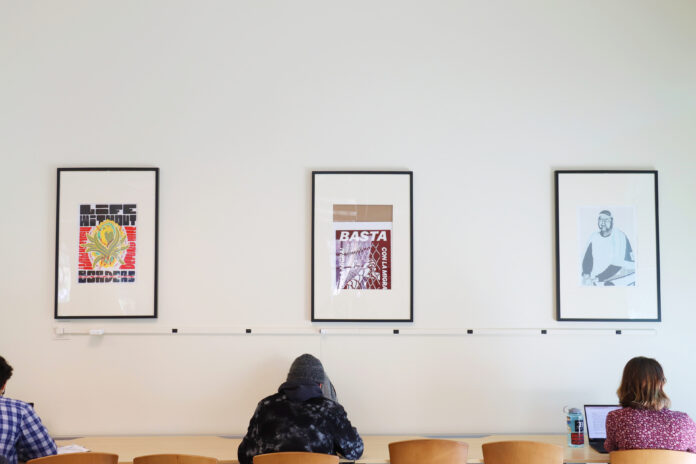Community members create posters and murals to promote well-being and celebrate culture
By MARIA MARTINEZ CASTRO — features@theaggie.org
Lea este artículo en español.
While on the UC Davis campus, students, staff and visitors might encounter colorful art posters depicting the culture and life experiences of the Chicanx and Latinx communities, as well as messages of advocacy, protest and empowerment.
Created by Taller Arte del Nuevo Amanecer (TANA), many of these posters line the walls of room 193 in Shields Library and call for change, recognition, celebration and community well-being.
TANA is a workshop space that serves as a silkscreen studio, art teaching center and Chicanx/Latinx exhibition space, according to the TANA website. Through its physical space and programs, TANA aims to promote community growth using art and culture.
Located in Woodland, TANA is a collaborative partnership between the UC Davis Chicana/o Studies program, the city of Davis, the city of Woodland and the surrounding communities.
The idea for TANA was born out of a collaboration process between its two cofounders, Carlos Jackson and Malaquias Montoya.
Montoya, who is a professor emeritus within the Chicana/o Studies Department, brought courses on silkscreen poster making (CHI 172) and mural making (CHI 171) to UC Davis. Jackson earned a Master of Fine Arts in Art Studio from UC Davis and is now the dean of the Stamps School of Art and Design.
As a student, Jackson approached Montoya with the idea of creating a community arts center. After the planning, construction and development process, TANA opened its physical space in 2010.
Montoya said that in developing his coursework and TANA, he was influenced by his previous experience and knowledge of community talleres, or workshops. Talleres focus on Chicanx/Latinx community empowerment and remembering history.
“I came out of the 60s, where workshops like this, talleres, were very important to our community,” Montoya said. “Artists founded talleres in the big cities, the big barrios, and the whole idea was to bring art to the communities that they were from. The idea was to educate our community and educate the children [about] our art.”
This is especially important because a lot of the culture and history of marginalized communities has been erased throughout time by colonialism, according to Montoya.
“Most of our families of that age had lost their culture because that’s what happens when you get conquered,” Montoya said. “The conqueror sees it very necessary to destroy one’s culture.”
TANA’s silkscreen printing workshops allow young and vulnerable community members to promote positive identity and civic participation, using art and culture as a means to strengthen community ties, according to their official webpage.
The posters serve as a voice for community members that have been historically silenced and speak on hidden history and social issues, Montoya said.
“The idea behind the poster is that it’d be a voice from us to our community,” Montoya said. “We […] give them a voice to speak about the injustice that we have in our communities. It’s just like the mural paintings of Diego Rivera [and] the artists in Mexico when [Jose] Vasconcelos, who was Minister of [Public Education], brought in artists to bring the history back to the community. The artists started to put down and paint the history of Mexico. In a sense, that’s what we’re doing. That’s what talleres do. Except talleres are [also] dealing with issues that are present daily, such as police brutality.”
Jose Arenas, TANA’s current director, said that the posters have the ability to inspire and encourage community members to hold conversations that lead to progress.
“We’re using the poster, the print, as a vehicle for self-expression and for speaking on issues that are happening in the community […] as something that can visually trigger ideas and dialogue and change,” Arenas said.
TANA allows for Chicanx/Latinx communities to be seen and empowered, Montoya said.
“By bringing art to the people, you awaken them to who they are and bring pride to them,” Montoya said. “And they look at themselves in a different way.”
To further reach, engage and empower the community, TANA creates murals with community organizations and partners. TANA’s mural component is an extension of the mural workshop within the UC Davis Chicana/o Studies program.
“In the case of the [mural making] class in [the] Chicana/o Studies Department, […] UC Davis students engage and [talk about] these issues with community members, then through that process, actually derive and [compose] an image, a mural, that really reflects those priorities.”
UC Davis students and youth from surrounding communities are at the center of TANA’s efforts. Through TANA’s collaboration with the Chicana/o Studies Department, UC Davis student interns assist in its operation by leading workshops, as well as organizing mentorship opportunities for Woodland youth.
“One of the things that we’re really focused on is deepening these regional partnerships with schools and youth-focused organizations,” Arenas said. “Essentially, we’re serving as an integral cultural center that hopefully enriches the lives of youth and families as we move forward in the community.”
According to Montoya, the heart of TANA exists in seeing Chicanx/Latinx families and the community come together through the creation of art and the celebration of culture.
“The most wonderful thing has been when we’ve had student exhibitions and students bring their parents to the opening,” Montoya said. “It brings tears sometimes just to think that this is the first time this son or daughter [has] taken their parents to see artwork at a gallery. I’ve found our community, [our] people don’t do that, really because we were never brought up that way. But now it’s just wonderful to see a mom and a grandfather stand there and have a young student or poster maker explain to them what they did and what they’re doing and what it was for. That’s, for me, the biggest satisfaction.”
Written by: Maria Martinez Castro — features@theaggie.org




